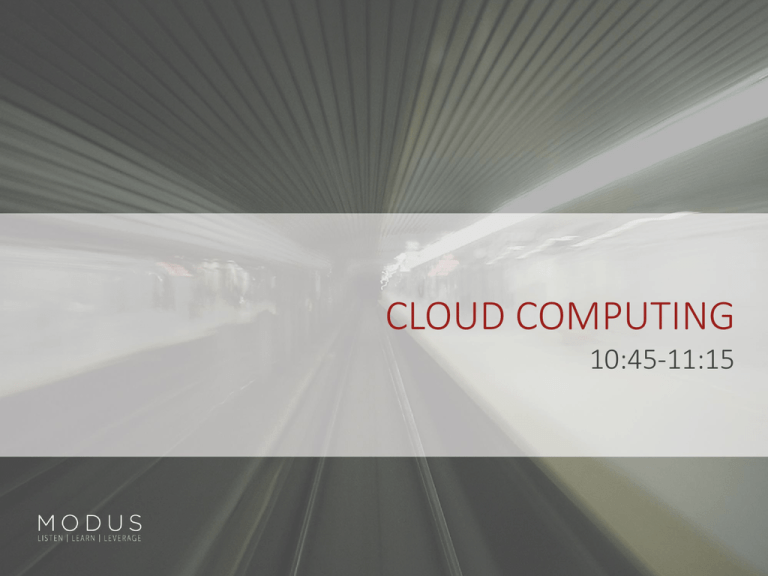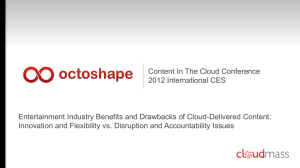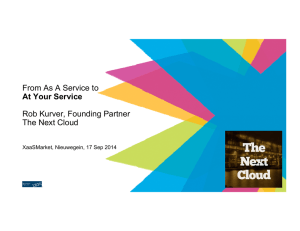ESI Workshop Cloud Computing
advertisement

CLOUD COMPUTING 10:45-11:15 CLOUD COMPUTING DEFINED General definition: Hosted services delivery over the Internet from a remote location, either over Internet or Intranet, involving environments enabled by virtualization. NIST definition: “Cloud computing is a model for enabling ubiquitous, convenient, on-demand network access to a shared pool of configurable computing resources (e.g., networks, servers, storage, applications, and services) that can be rapidly provisioned and released with minimal management effort or service provider interaction.“ CLOUD COMPUTING: ESSENTIAL CHARACTERISTICS On-demand self-service – Customer can provision “as-needed”, without requiring human interaction with a service provider Broad network access – Accessible cloud environment from any client platform, including smart phones, tables, computers, laptops, workstations Resource pooling – Sharing of o Storage o Memory o Network bandwidth CLOUD COMPUTING: ESSENTIAL CHARACTERISTICS, CONT. Rapid elasticity – Scale upwards and downwards, on demand/as needed – Deployed in little to no time – Appearance of seamless and unlimited Measured service – Cloud systems allocate resources automatically, depending on demand – Everything is measured – Resource usage is regularly/real time monitored, controlled and reported CLOUD COMPUTING SERVICE MODELS Software as a Service – Use providers applications, that run on provider’s cloud infrastructure – Generally accessible via web browser or program interface – Consumer/user does not manage or control underlying infrastructure, including network, servers, operating systems, storage or individual application capabilities – Examples: Outlook Webmail, Gmail, Twitter, Facebook, Flickr, LinkedIn, Dropbox, etc. CLOUD COMPUTING SERVICE MODELS, CONT. Platform as a Service – Use consumer-created or acquired applications, that run on provider’s cloud infrastructure – Generally accessible via web browser or program interface – Consumer/user does not manage or control underlying infrastructure, including network, servers, operating systems, storage but has control over or deployed applications and some configuration settings for the application-hosting environment – Examples: Salesforce1 PaaS, Google App Engine, Microsoft Azure, OutSystems, etc. CLOUD COMPUTING SERVICE MODELS, CONT. Infrastructure as a Service – Consumer/user is able to provision processing, storage, networks and other computing resources, where the consumer can deploy and run arbitrary software, including operating systems and applications. – The consumer does not manage or control underlying cloud infrastructure, but has control over operating systems, storage and deployed applications. – Examples: Amazon Web Services, CA Technologies, AT&T, Verizon, etc. CLOUD COMPUTING CLOUD TYPES Private cloud – – – – Cloud Infrastructure provisioned for exclusive use by single organization Can comprise multiple business units of that organization Owned/managed/operated by organization, third party or both Can be on or off-premise CLOUD COMPUTING CLOUD TYPES, CONT. Community cloud – Cloud Infrastructure provisioned for exclusive use by a specific community of consumers from organizations that have shared concerns – Owned/managed/operated by one or more if the organizations, third party or both – Can be on or off-premise CLOUD COMPUTING CLOUD TYPES, CONT. Public cloud – Cloud Infrastructure provisioned for open use by general public – Owned/managed/operated by business, academic or government organization (or combination of them) – Exists on premises of cloud provider CLOUD COMPUTING CLOUD TYPES, CONT. Hybrid Cloud – Cloud Infrastructure is a composition of two or more distinct cloud infrastructures (private, community or public) – Remain unique entities – Bound together by standardized or proprietary technology that enables data and application portability (e.g. load balancing between clouds) CLOUD COMPUTING LEGAL ISSUES Who controls the data? – Rule 34(a)(1): “A party may serve on any other party a request within the scope of rule 26(b) to produce…the following items within the responding party’s possession, custody or control” – Example Facebook TOS: o “You own all of the content and information you post on Facebook, and you can control how it is shared…” o But: “When you delete IP content…understand that removed content may persist in backup copies for reasonable period of time, unavailable to others.” CLOUD COMPUTING LEGAL ISSUES, CONT. Stored Communications Act – Designed to address privacy issues of internet communications not covered by 4th amendment – Creates set of 4th amendment-like privacy protections by statute, regulating the relationship between government investigators and service providers in possession of users’ private information – Two main purposes: o Limits governments rights to compel providers to disclose customer or subscriber information o Limits rights of Internet Service Providers (ISP’s) to provide customer information voluntarily CLOUD COMPUTING LEGAL ISSUES, CONT. Court determined Gmail, Facebook, Myspace and Hotmail as Electronic Communications Services (ECS) Provider and Remote Computing Services (RCS) Provider under Stored Communications Act Good read: Cloud Computing: Constitutional and Statutory Privacy Protections http://fas.org/sgp/crs/misc/R43015.pdf CLOUD COMPUTING COLLECTION ISSUES Saas, PaaS, IaaS – Challenges with multi-tenant hosting, sync problems and techniques for segregating data in shared logs – Traditional data/forensic collection involved physical collection, preservation, validation, processing, review and production – Cloud collections do not have physical media or physical control over network on which data resides. Difficult to identify specific data and segregate in shared/cloud environment = preservation and collection issue CLOUD COMPUTING COLLECTION ISSUES, CONT. Saas, PaaS, IaaS cont’d – Due to “elastic” capabilities of cloud (i.e. adding or removing available storage, virtual workstations, etc.), data can easily be “deleted” or overwritten – Other challenges include massive databases for CRM systems and social platforms – Great read: NIST Cloud Computing Forensic Science Challenges http://safegov.org/media/72648/nist_digital_for ensics_draft_8006.pdf - Annex “B” CLOUD COMPUTING COLLECTION ISSUES, CONT. Cloud-hosted email – All cloud providers of email and social media sites are likely ECA/RCS under Stored Communications Act (SCA) precluding ability to capture email without user authorization absent showing of probable cause – Collections under SCA typically done by government in criminal proceeding – In civil matters: will require user consent to retrieve data from the cloud, including username and password or given admin rights to mailbox CLOUD COMPUTING COLLECTION ISSUES, CONT. Cloud-hosted email cont’d – Some forensic data and metadata is lost when email is “downloaded” from cloud-based mailbox – Only the more “common” cloud-email providers offer eDiscovery collection abilities from within the administrative or user mailbox interface. Other cloud-email providers will have to collect for you, charging per mailbox or hourly. – Seek other sources (e.g. communicationrecipient’s email) first CLOUD COMPUTING COLLECTION ISSUES, CONT. Social Media – Without user consent: Can only download/collect what is publicly available (not requiring a username and password) – With user consent: Can collect any information available and visible to user, but will require account log-in information (i.e. username and password) – Exceptions are open content social media platforms, such as Twitter, YouTube, etc. CLOUD COMPUTING COLLECTION ISSUES, CONT. Social Media cont’d – Some social media sites do not allow you to “pick and choose” what you want to collect (e.g. Facebook) – True collect “all” from social media requires specialized collection software, such as X1 Social Discovery or platform-specific, such as the Afentis Suite of forensic software (have to purchase individual software, per platform) CLOUD COMPUTING COLLECTION ISSUES, CONT. Text messages – While cell phone providers do not keep transmitted data, logs of when transmissions occurred are kept for a limited time-frame (depending on the provider) – Result: Need to collect from physical device Interesting nugget: Uncle Sam is watching you, too! – Library of Congress collected all tweets via FOIA request – 50 million tweets per day NEXT TOPIC MICROSOFT EXCHANGE






